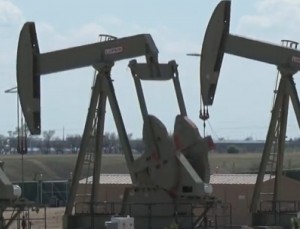
CHICAGO—With the price of oil now less than $80 a barrel, motorists throughout the United States are benefiting from gas prices below $3 a gallon. However, the decreasing price of gas has a downside for the hydraulic fracturing industry in the United States.
North Dakota’s economy is on fire, thanks to developments in technology that allow oil extraction from shale formations deep below the surface.
The process to extract that oil, known as hydraulic fracturing, or “fracking,” is the source of the economic boom for states on top of these deposits.
Now, that prosperity is trickling down to the rest of the country.
“Fracking is the miracle that has brought down gasoline prices,” said Phil Flynn, a senior market analyst with the PRICE Futures Group. Flynn said the rise in the number of wells, and developing and expanding the system to refine and transport shale oil, are game changers for U.S. energy independence.
“The quality of the oil produces more gasoline than your traditional barrel of oil, and refiners in the U.S. are rising to the occasion to take advantage of this,” said Flynn.
Austan Goolsbee, a Professor of Economics at the University of Chicago’s Booth School of Business, said that while production of oil and natural gas is dramatically higher in the United States, there is a downside.
“There is one issue — the cost of production in North America tends to be higher than in the cheapest places like Saudi Arabia,” said Goolsbee.
And Saudi Arabia knows this, which is why — according to Flynn — OPEC, or the Organization of the Petroleum Exporting Countries, of which Saudi Arabia is a leading member, has so far declined to curb production to maintain high market share.
“They’re trying to put the shale gas revolution on hold. They’re trying to flood the market with oil and drive prices even lower in the hopes the frackers will stop fracking,” said Flynn.
“On average, I would say that, once you start getting below a sustained $75 a barrel for oil, there would be a lot of domestic producers in the U.S. who say we can’t live at that sustained price. If the price went to $65 a barrel, and stayed there for several years, a lot of guys would go out of business,” explained Goolsbee.
Goolsbee said there are several other factors contributing to lower gas prices, including the increase in the number of fuel-efficient vehicles on the road and less demand from major consumers.
“Some of the biggest users of energy, like China, have slowed down. Their growth rate has slowed down pretty substantially, so there has been less demand,” he said.
Which is part of the reason Flynn thinks lower gas prices are here to stay.
“The combination of more fuel efficiency, more oil production, more refining capacity means lower gas prices for a long time to come,” said Flynn.
The American Automobile Association, or AAA, pegs the current average cost of gasoline in the U.S. at $2.85 a gallon – welcome news to motorists gearing up for long drives during the Thanksgiving holiday.


